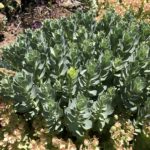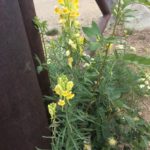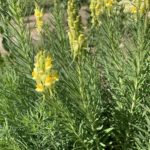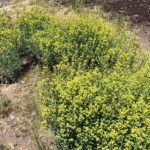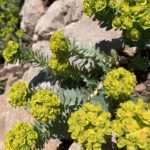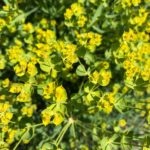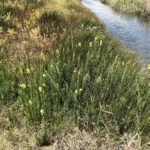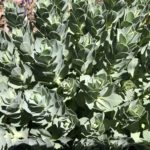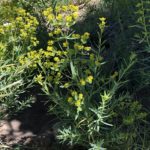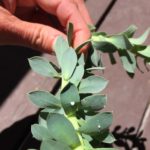Summit CWMA Yellow Toadflax and Myrtle Spurge Control Program
Introduction
The yellow toadflax (Linaria vulgaris) and Myrtle spurge (Euphorbia myrsinites) Summit CWMA control program is a partnership between members of the CWMA, Wasatch County and Wasatch State Park. Yellow toadflax (Class 1B) and Myrtle Spurge (Class 3) are Utah State listed noxious weeds. These weed species outcompete native vegetation, reducing forage for native wildlife and pollinators and both species have the potential to be toxic. Yellow toadflax contains a glucoside chemical that is poisonous to livestock if eaten. Myrtle spurge, on the other hand, presents health risks to humans and wildlife. The white sap that leaks from the plant when it is damaged can cause severe blisters and burns of the skin and can cause eye damage.
Summit CWMA Efforts - History and Revival
Like many noxious weeds, yellow toadflax does not respect property boundaries, so a multi-county collaboration is required. Summit and Wasatch Counties joined forces with the CWMA to map and treat this species over ten years ago. In 2010, the largest populations of yellow toadflax were known to be on the flat lands below Guardsman Pass, now called Bonanza Flat, and in the lands within and adjacent Deer Valley Resort. Since then, the species has moved along roadsides into Wasatch State Park. Early control efforts significantly reduced the distribution of yellow toadflax. However, due to changes in property ownership and a lack of funding, control efforts on Bonanza Flat were halted for several years. In 2018 after the area was purchased by Park City, control efforts resumed. Park City and Deer Valley Resort continue to control these populations in partnership with the rest of the Summit CWMA partners.
Myrtle Spurge populations on open space lands are more common outside Summit County and are invading from populations in Salt Lake and Wasatch Counties. Where it is found in Summit County, Myrtle spurge is typically in residential properties where is has been planted as a garden plant that is now escaping to open space. Because this plant has been sold in nurseries, many people are not aware that is it a noxious weed and often are reluctant to remove a plant that they have grown to love. In these cases, the Summit CWMA works with Summit County and Park City to educate these property owners about noxious weed laws and the health risks of this species. In the last 5 years, Summit County has even assisted these residents by treating the plants for them for one year. This effort helped to contain the species and set the residents on a path towards success.
The distribution of yellow toadflax and Myrtle Spurge are relatively limited making them species that can still be eradicated (completely removed). However, it is likely that there are many populations that have not been identified yet and that the extent of these species is underestimated. For this reason, the focus of Summit CWMA efforts for these species is heavily weighted towards mapping to allow for efficient control plans in the seasons that follow. Monitoring in 2021 identified new populations of both species, but also substantial populations of another noxious weed, Leafy Spurge. All three species are being mapped and the Summit CWMA, including Summit County, Park City Municipal Corporation, Deer Valley Resort and Ecology Bridge is partnering with Wasatch County and Wasatch State Park to conduct mapping and development of strategic control plans.
Control Efforts
The Summit CWMA uses an integrated pest management approach that assesses factors about the weed species, the site it has invaded, and the other plant species present to determine the best combination of weed control methods for the populations. The tools for integrated management include, hand weeding, tilling, grazing, mowing, solarization, herbicide, biological control, native plant restoration and more. This summer 14 acres of previously mapped yellow toadflax were revisited for monitoring and retreatment.
Herbicide
All three species, yellow toadflax, Myrtle spurge and leafy spurge are most effectively controlled with herbicide treatment. Due to the deep and complex rooting systems of these species, treatment often requires multiple years to kill the plants. Contractors for the Summit CWMA use selective herbicides that have shown to be most effective on these species and spot spray to minimize impacts on other species.
Hand Weeding
Hand weeding of yellow toadflax and leafy spurge is rarely effective due to their extensive roots. For these plants, weeding is typically used as a last-ditch effort to prevent new seed from reaching the soil. Newly established Myrtle spurge populations can be effectively controlled with a combination of weeding and herbicide. Weeding is also used to reduce the amount of plant material and shift the plants to a more sensitive state of regrowth that is more susceptible to herbicide treatments. The Summit CWMA uses this weeding and herbicide combination for the three known Myrtle spurge populations in open space areas of Summit County. For residential populations, the CWMA works with residents and Summit County to determine what the best treatments are on a case-by-case basis.
Biological Control Agents
Partnering with the Summit County Weed Supervisor, Utah Weed Supervisors Association and UDAF, we have been able to use biological control agents for yellow toadflax and leafy spurge. For yellow toadflax, we use a stem-boring weevil (Mecinus janthinus) that burrows into the plant’s stalk, doing irreparable damage to the weed. In mid-July 2021, 38 employees from restoration organizations spanning 7 of Utah’s counties gathered outside the town of Oakley in Summit County to collect the weevil from previously established populations. Collection efforts were organized by Utah’s Bug Girl, Amber Mendenhall, and just under 10,000 weevils were collected. The weevils have been redistributed to yellow and Dalmatian toadflax control efforts around the state, including known populations in Park City.
Leafy spurge has long been treated with the leafy spurge flea beetle (Apthona species). This biological control agent can be very effective at thinning leafy spurge populations but act slowly and can not completely eradicate the weed. Multiple, control methods are often used with biological control, particularly herbicide and grazing controlling leafy spurge.
One challenge with using biological control agents for most yellow toadflax and some leafy spurge in the Summit CWMA project areas is climate. These populations are at high elevations where plants grow slower than populations at lower elevations so the plants have not grown enough for biological control releases to work when the control agents are available. The cold and long winters can also make it difficult for the weevils to establish and survive year after year. For this reason, we have begun to reach out to suppliers that have facilities at higher elevations that may have biological control agents more suited to our sites.
Project Impacts
As of late summer 2023, over 26 acres of yellow toadflax, 3 acres of Myrtle spurge and 78 acres of leafy spurge have been mapped as a result of this project. Knowing where and how dense these populations are will allow the Summit CWMA and partners to develop control plans that suit conditions of these species, the sites they have invaded and the populations size and density to be as effective as possible.



